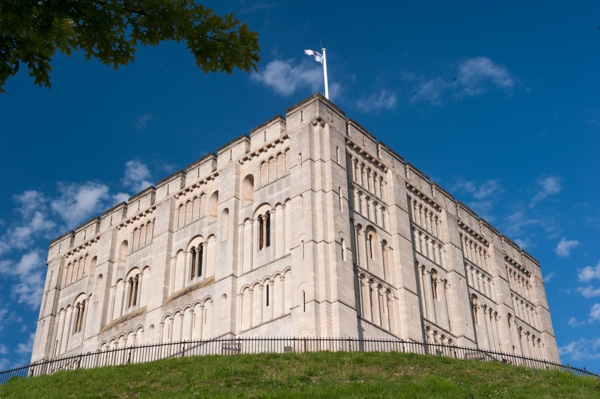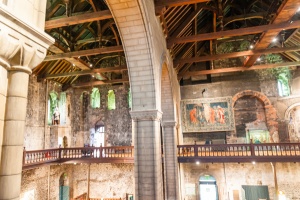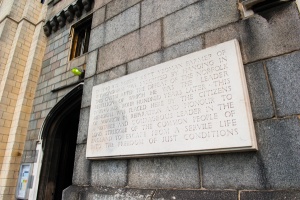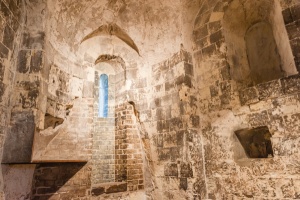
At the time of the Norman Conquest Norwich was the third-largest city in England, after only London and York. It should as no surprise then, that within a year of the Conquest the new king, William the Conqueror, began construction of a new motte and bailey fortress here.
Willam chose a natural hill within the existing city walls and cleared the site of about 100 existing Saxon houses. The Normans moulded the hill into a steep-sided mound, so wide that the hilltop could serve as the inner bailey. This mound was topped by a timber fort, and the base of the hill encircled within an outer bailey wall.

In 1075 disaffected Norman barons rose up in revolt and seized the castle. The revolt was put down, and one of the leaders, the Earl of Norfolk, fled abroad, leaving his Countess to hold the castle. This she did for three months, holding out against a superior royal force.
In 1094 Wiliam II began to rebuild the timber fortress in stone, possibly using slave labour drawn from the local British population. William died in 1100 and the work was finished by Henry I. The similarities between Henry's castle keep at Norwich and the castle he built at Falaise in Normandy are striking.
Henry intended Norwich Castle to serve as a royal residence as much as a defensive fortress, but in the end, no monarchs ever lived here. Henry himself is only known to have visited once when he stayed at Norwich for Christmas 1121.
The ground storey was originally faced with local flint, with royal quarters in the upper storeys faced in more expensive limestone from Caen. The royal quarters were provided with a chapel, bedchambers, parlour, and great hall.
During the abortive attempt to place the Dauphin of France on the English throne in 1216 the castle was besieged and captured. In 1268 Edward I built a curtain wall around the top of the motte, but only fragmentary footings of this wall remain.
In 1294 new city walls were built, enclosing a much larger area, so that Norwich Castle no longer stood on the edge of the city but in the centre. This inevitably meant that the castle lost its military importance.

Robert Kett
A simple plaque outside the main entrance to the keep tells the story of one of the most dramatic and tragic tales in the history of the castle. In 1549 Robert Kett was executed for his role in a popular rebellion against land enclosure. The memorial reads:
In 1549 AD Robert Kett, yeoman farmer of Wymondham was executed by hanging in this castle after the defeat of the Norfolk Rebellion of which he was the leader. In 1949 AD - four hundred years later - this memorial was placed here by the citizens of Norwich in reparation and honour to a notable and courageous leader in the long struggle of the common people of England to escape from a servile life into the freedom of just conditions.
From Gaol to Museum
Like many urban castles, Norwich gradually fell into disuse and as early as the 14th century the keep was used as the county gaol, a function it fulfilled until the late 18th century when a new set of prison buildings was designed by Sir John Soanes incorporating part of the keep.
These 18th-century prison buildings were rebuilt and enlarged in the 19th century, then in 1883 the gaol moved to a new location at Mousehold Heath and the castle was transformed into a museum. Part of that transformation included a new roof and a balcony inserted at the level of the old Norman hall.
Now Norwich Castle operates as the principal county museum, with displays of Lowestoft Porcelain, ceramic teapots, Norwich silver, and work by the Norwich School of Artists.

The first thing that strikes you when seeing Norwich Castle for the first time is that it looks 'too good'; the finely crafted blind arcades of the exterior walls of the keep are too clean and 'perfect'.
That impression is both true and false. The keep exterior as we see it today is the work of architect Anthony Salvin, who refaced the exterior in Bath stone beginning in 1834.
However, it seems clear that Salvin followed the original medieval design closely, so what we see today is very close to what medieval citizens of Norwich would have seen when they looked up at the gleaming white castle on its high mound.
A Family Visit to Norwich Castle
There are really two separate parts of the castle; the Keep, and the Museum, and each has separate admission, though a joint ticket is available. Our family opted for a joint ticket, over the objections of our daughter, who isn't keen on museums at the best of times. Our first stop was the Keep.
The ground floor is filled with displays of local history, many aimed at getting children interested in the history of the castle. There are hands-on displays were children can build a castle, try on period costumes, and get an idea of what life was like in the medieval castle. We joined a fun event by a costumed 'rat-catcher' who got the children to find stuffed 'rats' that were hiding around the castle.
Our daughter had a wonderful time racing the clock to find as many rats as possible in a set time limit. When the game was over we explored the keep at leisure. It doesn't actually take that long; you can descend to the cellars for a look at the foundations, and up to the first floor to see minimal remains of chambers built into the walls where the royal apartments would have stood. Of these, the best historic feature was the king's chapel, with vestiges of carved capitals.
Then it was off to the museums. We quite enjoyed the Saxon museum; there were some very interesting exhibits, but our budding Egyptologist daughter spent much more time looking at the Egyptian displays - an odd choice of displays for a Norman castle I thought, but still worth a look.
We spent a couple of hours in the castle before the younger generation finally rebelled and we called it quits. My impression is that there really is a bit of something for everyone at the castle. The museum galleries are excellent, and the Keep interior should really help give visitors an idea of the history of the castle and the city.
About Norwich Castle
Address: Castle Meadow,
Norwich,
East Anglia,
Norfolk,
England, NR1 3JU
Attraction Type: Castle
Website: Norwich Castle
Email: museums@norfolk.gov.uk
Location
map
OS: TG231085
Photo Credit: David Ross and Britain Express
HERITAGE
 We've 'tagged' this attraction information to help you find related historic attractions and learn more about major time periods mentioned.
We've 'tagged' this attraction information to help you find related historic attractions and learn more about major time periods mentioned.
Historic Time Periods:
Find other attractions tagged with:
14th century (Time Period) - 18th century (Time Period) - 19th century (Time Period) - castle (Architecture) - Edward I (Person) - Henry I (Person) - Medieval (Time Period) - motte and bailey (Historical Reference) - Norman (Architecture) - Saxon (Time Period) - William the Conqueror (Person) -
NEARBY HISTORIC ATTRACTIONS
Heritage Rated from 1- 5 (low to exceptional) on historic interest
Bridewell Museum - 0.1 miles (Museum) ![]()
Norwich, St Michael at Plea - 0.1 miles (Historic Church) ![]()
Armada House - 0.1 miles (Historic Building) ![]()
Norwich, St Peter Mancroft - 0.2 miles (Historic Church) ![]()
The Halls - 0.2 miles (Historic Church) ![]()
St George Tombland - 0.2 miles (Historic Church) ![]()
Norwich Guildhall - 0.2 miles (Historic Building) ![]()
Norwich, St John Timberhill - 0.2 miles (Historic Church) ![]()







